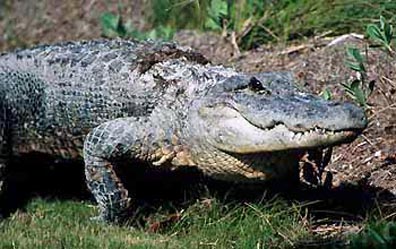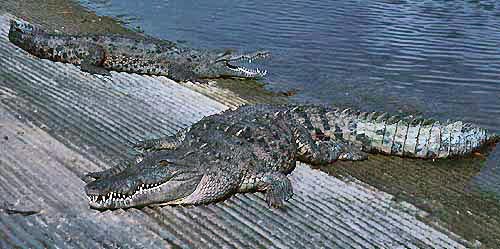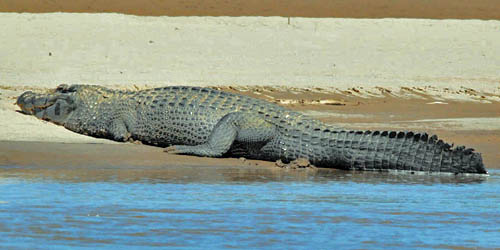
a web page by Don Roberson |
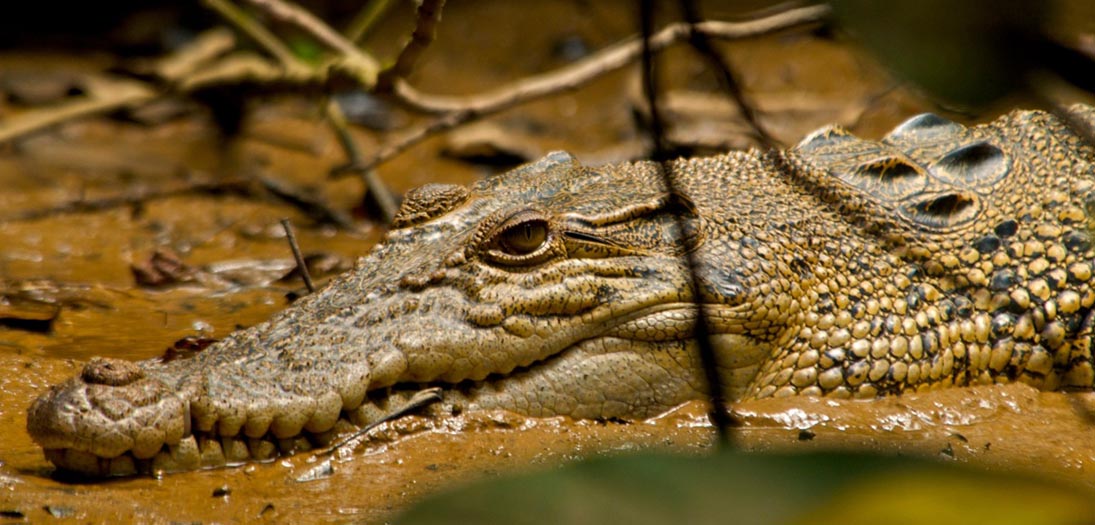 |
||||||
Saltwater Crocodile in Sabah, Malaysian Borneo © David Bishop (above) |
||||||
| Which large croc makes you the most afraid? For me it has always been Nile Crocodile that is the most scary, but others have a different choice. Alderton (1998) begins his discussion of man-eating crocodiles this way: "It is impossible to estimate the numbers of people who fall victim to crocodile attacks each year. Indeed, in some cases, there is simply no obvious trace left of the person, and their disappearance may remain a mystery, ... [but] perhaps 3000 people are seized, mutilated and, in most cases, eaten by crocodiles annually. The vast majority of victims are attacked by the [Saltwater/Estuarine/Indo-Pacific] Crocodile Crocodylus porosus, while the Nile Crocodile Crocodylus niloticus is almost as dangerous." So that author plumps for what I'll call Saltwater Crocodile C. porosus — sometimes simply called the "Saltie" in outback Australia — which is the English name preferred by David Quammen in his book. [Monster of God has a full chapter on the relationship between humans (especially aboriginal people) and crocs near Darwin, Northern Territories, Australia.] | ||||||
Truth is, I've not yet seen a Saltwater Crocodile so it is not in my consciousness the way Nile Crocodile is. But since my friends David Bishop (photo above) and John Sullivan (photos right and below) lent me such lovely photos, I'm happy to place it first on this page. Certainly that is an obvious awareness of its danger in northern Australia (photo of sign, right, from Kakadu NP). Yellow Water Billabong (below left) in Kakadu NP is excellent habitat for the yellow-eyed monster Salties (below right). Australian philosopher Val Plumwood survived a prolonged Saltwater Crocodile attack during a solo canoe excursion in Kakadu National Park in 1985. Plumwood recounted the details of the attack and her escape in her 1996 essay "Being Prey" (available on-line). Following the attack she spent a month in intensive care in a Darwin hospital and required extensive skin grafts. |
||||||
|
||||||
Val Plumwood set the scene for her story this way: "Not long ago, saltwater crocodiles were considered endangered, as virtually all mature animals in Australia's north were shot by commercial hunters. But after a decade and more of protection, they are now the most plentiful of the large animals of Kakadu National Park. I was actively involved in preserving such places, and for me, the crocodile was a symbol of the power and integrity of this place and the incredible richness of its aquatic habitats. I would be safe from crocodiles in the canoe—I had been told—but swimming and standing or wading at the water's edge were dangerous. Edges are one of the crocodile's favorite food-capturing places." This is an excellent summary of conventional wisdom — and yet, Val was attacked while in her canoe by a crocodile intent on capsizing it and eating her. This single-mindedness of purpose — to consume prey — makes these great saurians particularly scary. Saltwater Crocodile has a wide range in southern Asia and Australasia. It occurs from the coastal shores of the Indian subcontinent through southeast Asia to the Philippines, Indonesia, the island of New Guinea, and northern Australia. Some of the more famous 'man-eaters' have been on Borneo, including "Whiteback" (photo in the Introduction), a 5.8m (19 ft) crocodile in Sarawak, Borneo, that killed 13 people before it was caught in 1992. |
||||||
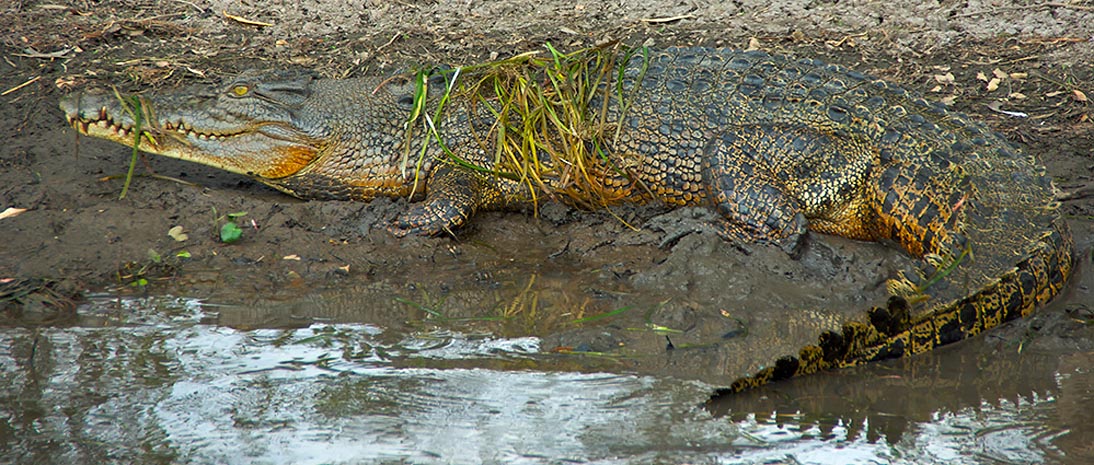 |
||||||
Saltwater Crocodile on 16 Nov 1994 Kakadu NP, Northern Territories, Australia © John Sullivan (above; John also took the other shots from Kakadu NP shown above this portrait) |
||||||
Nile Crocodile in Nov 1981 at Samburu NP, Kenya © Don Roberson (below) |
||||||
 |
||||||
My worst nightmares are of Nile Crocodile Crocodylus niloticus. If hungry, these prehistoric predators will target any mammal that comes within reasonable grasp. They are the major threat to the immense herds of wildebeest and zebra that cross the Mara River twice annually on their migration between Kenya and Tanzania. For a human, one would think that swimming in croc-infested waters expresses a death wish. Walking along the river-edge can be exceedingly dangerous, and crocodiles can be amazingly fast. Recent attacks on canoeists and kayakers are particularly chilling. A study by the on-line IUCN-SSC Crocodile Specialist Group estimated the number of attacks by Nile Crocodiles per year as 275 to 745, of which 63% are fatal, as opposed to an estimated 30 attacks per year by Saltwater Crocodiles, of which 50% are fatal. In both species, the mean size of crocodiles involved in nonfatal attacks was about 3 m (9.8 ft) as opposed to a reported range of 2.5–5 m (8.2–16 ft) or larger for crocodiles responsible for fatal attacks. Since a majority of fatal attacks are believed to be predatory in nature, the Nile Crocodile can be considered the most prolific predator of humans among wild animals. |
||||||
This screen-shot (right) is taken from the National Geographic (2002) movie Capturing the Killer Croc, aired on PBS in 2004 (this single shot is used per the "fair use" doctrine). There is spectacular footage of this incredibly huge beast [the two birds shown in this screen-shot are Wattled Lapwings — quite large lapwings that give some perspective]. The show follows the efforts of Patrice Fey and other scientists in an attempt to capture "Gustave." The attempt fails and "Gustave" disappears; per Wikipedia, it has not been seen since 2008. Villagers claim that sometimes "Gustave" attacks just to kill, not to eat. The film shows that "Gustave" has three bullet scars and an injured shoulder blade (from a spear?); this male has reason to be very cautious (as shown in the film), and he could have an antipathy to humans. ["Gustave" is also the basis for the fictional film Primeval, which follows a news team sent to Burundi to capture an exaggerated version of "Gustave." Despite a similarity to Jaws, the film was a lot better than I had anticipated.] |
||||||
Modern crocodiles are close relatives of the ancient dinosaurs. The contemporary genus Crocodylus was in existence by the late Cretaceous period, which ended 66 million years ago. They survived the great extinction at the K–Pg boundary — the mass extinction of non-avian dinosaurs between the Mesozoic and Cenozoic Eras. They have remained pretty much unchanged since then. In a very real sense, to encounter a large crocodile is to encounter a dinosaur. Encounters with giant crocodiles can be done safely in many of Africa's national parks. The Nile Crocodile is widespread in sub-Saharan Africa and downright abundant along some major lakes and rivers. Individuals like to bask in the sun and can be viewed from bridges, roadways, and overlooks. When I visited Samburu NP in northern Kenya in 1981, there was a "crocodile bar" — an outdoor bar/restaurant built above the riverbank. In the evenings meat scraps were routinely tossed onto the riverbank, and large crocs would come ashore to munch on these leftovers just below the many tourists sitting above (my initial photo, above, is taken at night from the "crocodile bar"). I don't know if the "crocodile bar" still exists. One can also see crocodiles routinely on boat trips on African lakes and rivers, but I would personally be very hesitant to kayak or canoe in croc-infested waters. In 2006, medical professor Richard Root — who had moved to Botswana in his retirement to alleviate the shortage of physicians there — was pulled from a dugout canoe during a wildlife tour of the Limpopo River. A 13-foot crocodile tipped over the canoe, and pulled Root under and drowned him, while his wife watched from another canoe. In 2010, famed South African outdoorsman Hendri Coetzee was killed while kayaking with two other experienced men on the Lukuga River in the Congo. The trip was the first-of-its-kind expedition from the White Nile into the Congo to explore the Rusizi and Lualaba rivers. The three kayakers were in the best possible formation to avoid crocodile attack, and yet a huge crocodile lept from the river, grabbed Coetzee in his seat, twisted him out of the kayak, and then was gone. I was thunderstruck when I read the story in the news. Coetzee was extremely experienced and did everything 'right' and yet, that wasn't enough. Whatever your terror may be, the Nile Crocodile is mine. |
||||||
 |
||||||
Nile Crocodile in Nov 1981 at Samburu NP, Kenya© Don Roberson (above) |
||||||
Mugger Crocodile in March 2001 Corbett NP, India © Don Roberson (below)
|
||||||
 |
||||||
Mugger Crocodile (also called Marsh Crocodile) Crocodylus palustris is the large freshwater crocodile of the Indian subcontinent and Sri Lanka. It inhabits the major rivers of India (i.e., Ganges, Brahmaputra, etc.) as well as inland lakes. [It is my choice to replace Quammen's pick from these river systems: Ganges Shark Glyphis gangeticus), an endangered species that has long been mistakenly tagged as a man-eater. Most, if not all, of attacks attributed to Ganges Shark are the work of Bull Shark Carcharhinus leucas, known to forage well upstream in freshwater rivers. Further, the morphology of the mouth and teeth of the freshwater shark are not conducive to attacks on humans.] While Mugger Crocodile can grow quite large (up to 4m = 13 ft.), it is not nearly as dangerous as either Saltwater or Nile crocodiles. Most adults measure 1.8 to 2.4m (6-8 ft.) which is typically too small to regularly take adult humans. In many locations it co-exists in apparent peace with huge numbers of people. They will scavenge the bodies of Hindus who are cremated in burial rites and then placed in the river. Herpetologist Mark O'Shea states "that although they will attack like other crocs I do not consider them man-eaters." Fair enough, but reports of attacks on humans can be found in the news (e.g., 12-year-old boy said to have been attacked and swallowed at the National Chambal Sanctuary, Madhya Pradesh, on 8 Dec 2012) and in scientific literature. Vyas (1993, 2012) documented attacks in Gujarat. While perhaps a majority of attacks might have been defensive during the breeding season, some involved man-eating. Recognizing that Quammen's definition of "monsters of god" include those that may exist in the "jungles of our mind," this feared predator qualifies for this list. The name —Mugger — is derived from the Hindustani word for "water monster." However, much like Jaguar and Anaconda (q.v.), its reputation as a man-eating predator may not match reality. Compared to the very dangerous Saltwater and Nile crocodiles, Muggers are more reminiscent of American Alligator Alligator mississippiensis. The head and snout are broader than the two other large crocodiles — more like an alligator — and their lifestyle recalls alligators (Alderton 1992). Mugger Crocodiles have declined throughout India and now conservation efforts are underway to protect them (see Vyas 2012 for just one example). We encountered big impressive examples of this crocodile sunning on the banks of the Ramganga River in Corbett NP (photo above) and smaller ones in the larger lakes at Ranthambhor Preserve, Rajasthan. I certainly did not have the feeling of dread about Muggers as I do with Nile Crocodiles. Muggers are revered in the Hindu religion and there are temples on lakes where large ones are regularly fed. Some assert that the over-feeding of these large Muggers has kept them from attacking humans. |
||||||
Other crocodilians: Although the Saltwater and Nile Crocodiles are by far the most dangerous of the family, and Mugger Crocodile may pose a danger locally, at least three other species have attacked, and likely eaten, humans: American Alligator Alligator mississippiensis, American Crocodile Crocodylus acutus, and Black Caiman Melanosuchus niger. The Crocodile Study Group (CSG) included American Alligator attacks in their study, less than 6% of which were fatal. The fatal attacks were mostly by large 3m (10 ft.) alligators. One large (4.5m = nearly 15 ft.) alligator on the border between Florida and Alabama in the 1920s was the legendary "Two-toed Tom." The stories are mostly folk-tales, but it was supposed to have killed many poor folk living around the swamps, and some claim a huge two-toed alligator was still present in the 1980s. Efforts to dynamite it from its favorite pond backfired, and it is said it became a more focused man-eater thereafter. Whatever one might think of this mostly undocumented legend, there still are fatal attacks by American Alligators to this day. However, most appear to be defensive –— especially during the breeding season when American Alligator is quite territorial. American Crocodile reaches a large enough size to be dangerous; large males have reached 6.1m (20 ft.). It is the only crocodilian, other than the Old World Saltwater Crocodile, to thrive in saltwater. Populations occur along both coasts of southern Mexico to South America as far as Peru and Venezuela. in the Caribbean, and in southern Florida. It can be reasonably common in some places (e.g., coastal Costa Rica) but is an endangered species within the United States. However, populations have rebounded in recent decades with perhaps 2000 present in Florida. Few attacks on humans have been well-documented, but in 2007 there were reportedly fatal attacks on children in Mexico and Costa Rica. Recent (unsuccessful) attacks on people were reported just this year (2013) in Mexico and in Florida. Black Caiman is the largest predator in the Amazon ecosystem, preying on a variety of fish, reptiles, birds, and mammals. They are generalists and an apex predator, potentially capable of taking any animal within its range, including other predators or humans (CSG). Jaguars and Green Anaconda are known to take young Black Caimans, but very large ones (some rumored to 6m, or nearly 20 ft. long) have no natural enemies. Jaguar researcher Paul Donahue wrote that "in protected areas Black Caiman can get very large, 4-5 m (=13-16 ft), and they do eat people. I know of at least two fatal attacks just along the Rio Manu in Peru: one tourist and one biologist." |
||||||
|
||||||
Click below for the next page of this project OR use these LINKS to the SPECIES PAGES
|
||||||
Photos: All photos © Don Roberson, except as otherwise attributed; all rights reserved. Literature cited:
|
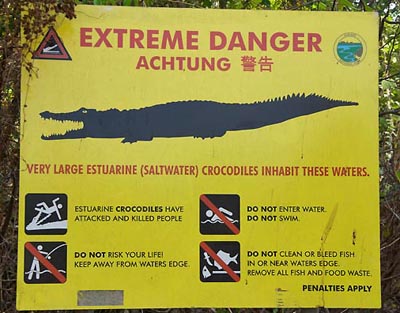 Yet,
the on-line IUCN-SSC Crocodile Specialist Group — a worldwide network
of biologists, wildlife managers, government officials, and independent
researchers — states on its
Yet,
the on-line IUCN-SSC Crocodile Specialist Group — a worldwide network
of biologists, wildlife managers, government officials, and independent
researchers — states on its 

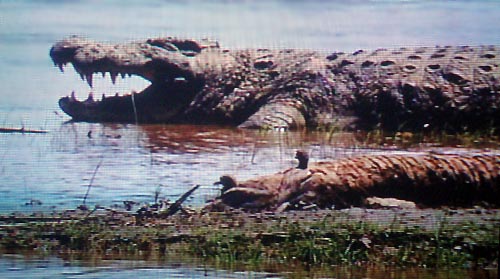 "The
number of human casualties involved far exceeds those taken by that
great aquatic group of predators, the sharks. This is a direct
reflection of the fact that human beings and crocodiles live in close
proximity to each other" (Alderton 1992). The most infamous Nile
Crocodile is a huge 6m (20 ft) behemoth for the Rusizi River and
northern Lake Tanganyika, Burundi. Named "Gustave" by researchers and
villagers, it may weigh a ton. It is believed to have killed and
consumed as many as 300 humans. Many villagers rely on fishing for food
and the river for water and washing, so potential encounters with
people can occur daily.
"The
number of human casualties involved far exceeds those taken by that
great aquatic group of predators, the sharks. This is a direct
reflection of the fact that human beings and crocodiles live in close
proximity to each other" (Alderton 1992). The most infamous Nile
Crocodile is a huge 6m (20 ft) behemoth for the Rusizi River and
northern Lake Tanganyika, Burundi. Named "Gustave" by researchers and
villagers, it may weigh a ton. It is believed to have killed and
consumed as many as 300 humans. Many villagers rely on fishing for food
and the river for water and washing, so potential encounters with
people can occur daily. 